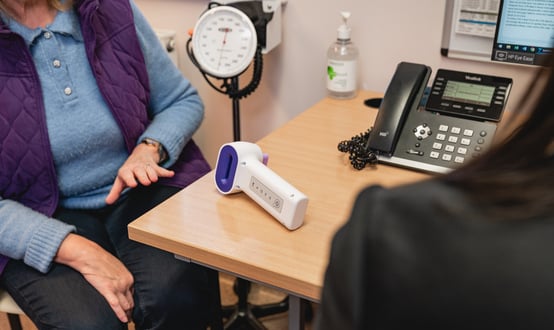Digital Health interview: Sir Jonathan Michael
- 13 October 2015

Working in a Birmingham renal unit in the early 1990s, Jonathan Michael and his colleagues had a problem, and they decided to solve it using technology.
They developed an electronic patient record, which continued to be developed by what became University Hospitals Birmingham NHS Foundation Trust to become the system used across the organisation.
“It started off by a group of clinicians getting swamped by data – a large number of patients and a lot of results – and trying to find a way of managing that more effectively and safely,” he says.
“That was the beginning of an important journey for me because I learned that health care IT was fundamental to patient safety and the quality of care. When I moved into a managerial role I saw the importance of IT not only for looking after health care information, but managing the business.
“So as a clinician and a manger I became a very strong supporter of the NHS getting more serious about IT and health care.”
Getting serious about health IT
Since those early days, Sir Jonathan has gone on to work as chief executive at three major acute trusts, as well as heading up British Telecom’s Health division from 2007 to 2010. He received his knighthood in the 2005 New Year’s Honours.
Throughout his career, he has been a strong and consistent voice in favour of digitising the NHS. Early on, that made him one of a few.
Now, he says, he is leaving the NHS at a time when there are plenty of other technology advocates who share his commitment and understand the importance of health care IT.
“Increasingly people are realising that if we are going to deliver the sort of integrated care for patients that they want we have to be slicker and have more integrated information exchange – and that’s coming,” he says. “There are a lot of enthusiasts around the NHS; they won’t miss my lone voice.”
However, he is concerned about the ability of the NHS to invest in the technology it needs to transform itself. “The reality is that the NHS is not yet committing enough resource to information technology compared with many industries.
“It’s not an easy time to be saying that because of the overall financial constraints of the country and the NHS , but as we go forward, if IT is going to be fundamental to the way we deliver are, we have to commit more than 1-2% of turnover to IT.”
Building a business case for investment in IT is often not an easy task, though. Sir Jonathan says some things have a quick return on investment in terms of efficiency and savings; as an example, he cites RFID tracking of paper records.
Bigger projects like a hospital-wide EPR involve a much bigger investment and the financial return is often quite slow. Sir Jonathan says boards have to accept that it will improve overall efficiency and quality of care over a period of time.
Taking time
In addition, many trusts that have gone down the EPR route have hit problems. In the past few weeks, the high profile implementation of the Epic EPR as part of a £200 million eHospital programme at Cambridge University Hospitals NHS Foundation Trust has been identified by the Care Quality Commission and Monitor as contributing to the trust’s significant financial woes.
Sir Jonathan hopes this will not put others off. “I don’t know how much of the recent problems are attributable to Epic, but I think it would be a great mistake if people got frightened off because individual organisations had some difficulties,” he says.
“To be honest, deployment is always difficult. I worked with a lot of trusts at BT; it was a learning curve. We had our own difficulties at Oxford [which went live with Cerner Millennium in late 2011]. It’s going successfully now, but it was difficult to start with, and you have got to expect that and be grown up.”
Sir Jonathan became chief executive of Oxford University Hospitals NHS Trust the year before the go-live, which was one of the last to be organised as part of the Southern Programme for IT in the NHS. The trust has chosen to keep Millennium through a direct contract with Cerner when NPfIT agreements expire at the end of this month.
Back in 2011, the trust reported problems with booking in patients and there were calls for the whole Cerner programme to be halted after another late-deploying trust, North Bristol, experienced similar issues.
Yet this month Oxford won the EHI Award 2015 for ‘digital NHS trust of the year’ and is regularly held up as an exemplar for adoption of electronic patient records.
Sir Jonathan says the trust took a “measured approach” with an iterative deployment of clinical systems. “You learn as you go. You don’t always get it right first time and you need to work with clinicians to make sure the product does for them what they want.”
Despite his departure, Sir Jonathan says Oxford remains “absolutely committed to a digital future” and it will only become more important as mental health, community providers, GPs and even social services look to share information.
Speaking out
There is a certain irony that Sir Jonathan is now so closely associated with BT Health, NPfIT’s local service provider for London and, latterly, parts of the South, and with Oxford’s Cerner deployment.
A decade ago, it was no great secret that he was “not particularly enamoured” with the programme. In fact, he gave a lecture in 2006 at London’s City Hospital explaining why it would not work.
He accurately predicted a fundamental problem which was that NPfIT was predicated on a standard ‘one-size-fits-all’ approach at a time when the NHS was increasingly de-centralising. “Perhaps it was not tactful but it was true,” he reflects now.
At BT, he was asked to persuade 32 trusts across London to take “exactly the same black box into their hospitals”. They all wanted to tweak it to make it more usable for them – but when presented with a “take it or leave it” standardised approach, most of them left it.
Eventually, BT came up with a more flexible deployment model, giving trusts at least some leeway over what they deployed and when, and more access to Cerner’s developers.
Despite this, and despite acknowledging that some national projects – such as the development of the NHS Spine and the picture archiving and communications systems programme – were successful, Sir Jonathan believes a better approach would have been similar to the one being adopted now.
This involves having a series of standards that systems must comply with, but leaving the choice of system up to individual organisations. The challenges, of course, are those financial ones, the risks that some trusts will fail to digitise, and the risk of new service models – vanguards, chains – demanding completely new patterns of IT deployment.
Moving on
6PM announced in September that Sir Jonathan would be joining as chief medical officer. He worked with the company during his time with BT and says he is pleased to be able to help it develop its health care strategy and products such as iFIT and StrokePad.
“It’s not that I’m leaving the NHS for a software supplier; I did that once when I left the NHS and joined BT,” he explains.
“This time I’m retiring from the NHS and from my position at Oxford having had a pretty long and fulfilling career. When 6PM heard that I was retiring, they approached me and asked if I would help on a part-time basis to act as a health care clinical specialist and I was pleased to do so.”
After all, as he said in a statement in September, capturing, handling and sharing information remains an essential challenge.
“The future challenge is going to be how we are going to redesign the way we deliver healthcare, so that it is more focused on being responsive to what patients need. That means we need to be able to share information, not just within the health and care system, but with patients.”




